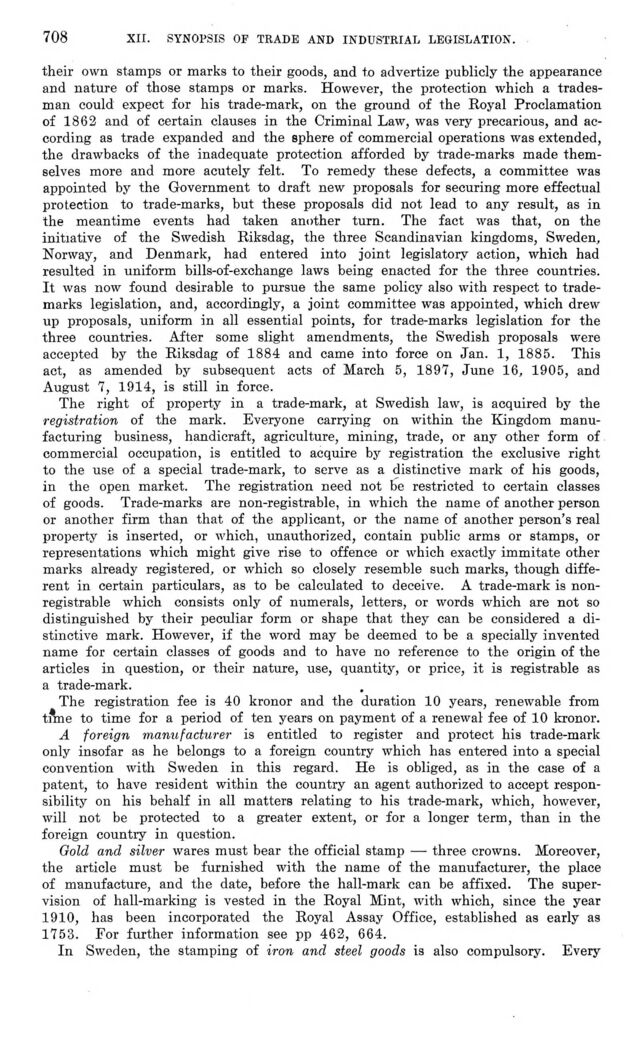
Full resolution (JPEG) - On this page / på denna sida - XII. Synopsis of Trade and Industrial Legislation. By J. Tjerneld - Trade-Marks. By Nils Rahm

<< prev. page << föreg. sida << >> nästa sida >> next page >>
Below is the raw OCR text
from the above scanned image.
Do you see an error? Proofread the page now!
Här nedan syns maskintolkade texten från faksimilbilden ovan.
Ser du något fel? Korrekturläs sidan nu!
This page has never been proofread. / Denna sida har aldrig korrekturlästs.
708
XII. SYNOPSIS OF TRADE AND INDUSTRIAL LEGISLATION.
their own stamps or marks to their goods, and to advertize publicly the appearance
and nature of those stamps or marks. However, the protection which a
tradesman could expect for his trade-mark, on the ground of the Royal Proclamation
of 1862 and of certain clauses in the Criminal Law, was very precarious, and
according as trade expanded and the sphere of commercial operations was extended,
the drawbacks of the inadequate protection afforded by trade-marks made
themselves more and more acutely felt. To remedy these defects, a committee was
appointed by the Government to draft new proposals for securing more effectual
protection to trade-marks, but these proposals did not lead to any result, as in
the meantime events had taken another turn. The fact was that, on the
initiative of the Swedish Riksdag, the three Scandinavian kingdoms, Sweden,
Norway, and Denmark, had entered into joint legislatory action, which had
resulted in uniform bills-of-exchange laws being enacted for the three countries.
It was now found desirable to pursue the same policy also with respect to
trademarks legislation, and, accordingly, a joint committee was appointed, which drew
up proposals, uniform in all essential points, for trade-marks legislation for the
three countries. After some slight amendments, the Swedish proposals were
accepted by the Riksdag of 1884 and came into force on Jan. 1, 1885. This
act, as amended by subsequent acts of March 5, 1897, June 16, 1905, and
August 7, 1914, is still in force.
The right of property in a trade-mark, at Swedish law, is acquired by the
registration of the mark. Everyone carrying on within the Kingdom
manufacturing business, handicraft, agriculture, mining, trade, or any other form of
commercial occupation, is entitled to acquire by registration the exclusive right
to the use of a special trade-mark, to serve as a distinctive mark of his goods,
in the open market. The registration need not be restricted to certain classes
of goods. Trade-marks are non-registrable, in which the name of another person
or another firm than that of the applicant, or the name of another person’s real
property is inserted, or which, unauthorized, contain public arms or stamps, or
representations which might give rise to offence or which exactly immitate other
marks already registered, or which so closely resemble such marks, though
different in certain particulars, as to be calculated to deceive. A trade-mark is
non-registrable which consists only of numerals, letters, or words which are not so
distinguished by their peculiar form or shape that they can be considered a
distinctive mark. However, if the word may be deemed to be a specially invented
name for certain classes of goods and to have no reference to the origin of the
articles in question, or their nature, use, quantity, or price, it is registrable as
a trade-mark.
The registration fee is 40 kronor and the duration 10 years, renewable from
tfme to time for a period of ten years on payment of a renewal fee of 10 kronor.
A foreign manufacturer is entitled to register and protect his trade-mark
only insofar as he belongs to a foreign country which has entered into a special
convention with Sweden in this regard. He is obliged, as in the case of a
patent, to have resident within the country an agent authorized to accept
responsibility on his behalf in all matters relating to his trade-mark, which, however,
will not be protected to a greater extent, or for a longer term, than in the
foreign country in question.
Gold and silver wares must bear the official stamp — three crowns. Moreover,
the article must be furnished with the name of the manufacturer, the place
of manufacture, and the date, before the hall-mark can be affixed. The
supervision of hall-marking is vested in the Royal Mint, with which, since the year
1910, has been incorporated the Royal Assay Office, established as early as
1753. For further information see pp 462, 664.
In Sweden, the stamping of iron and steel goods is also compulsory. Every
<< prev. page << föreg. sida << >> nästa sida >> next page >>